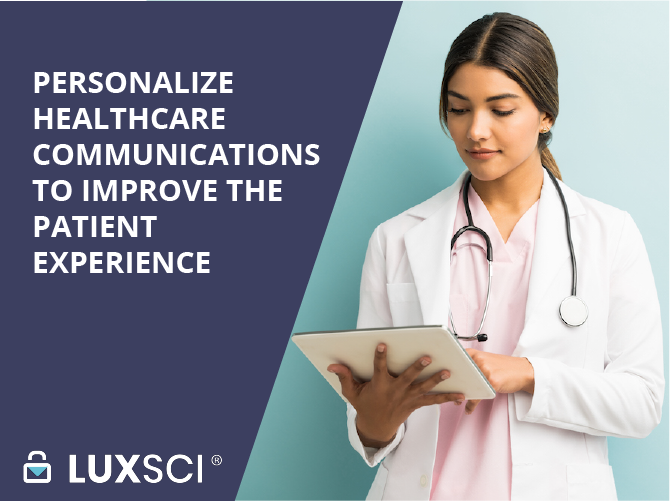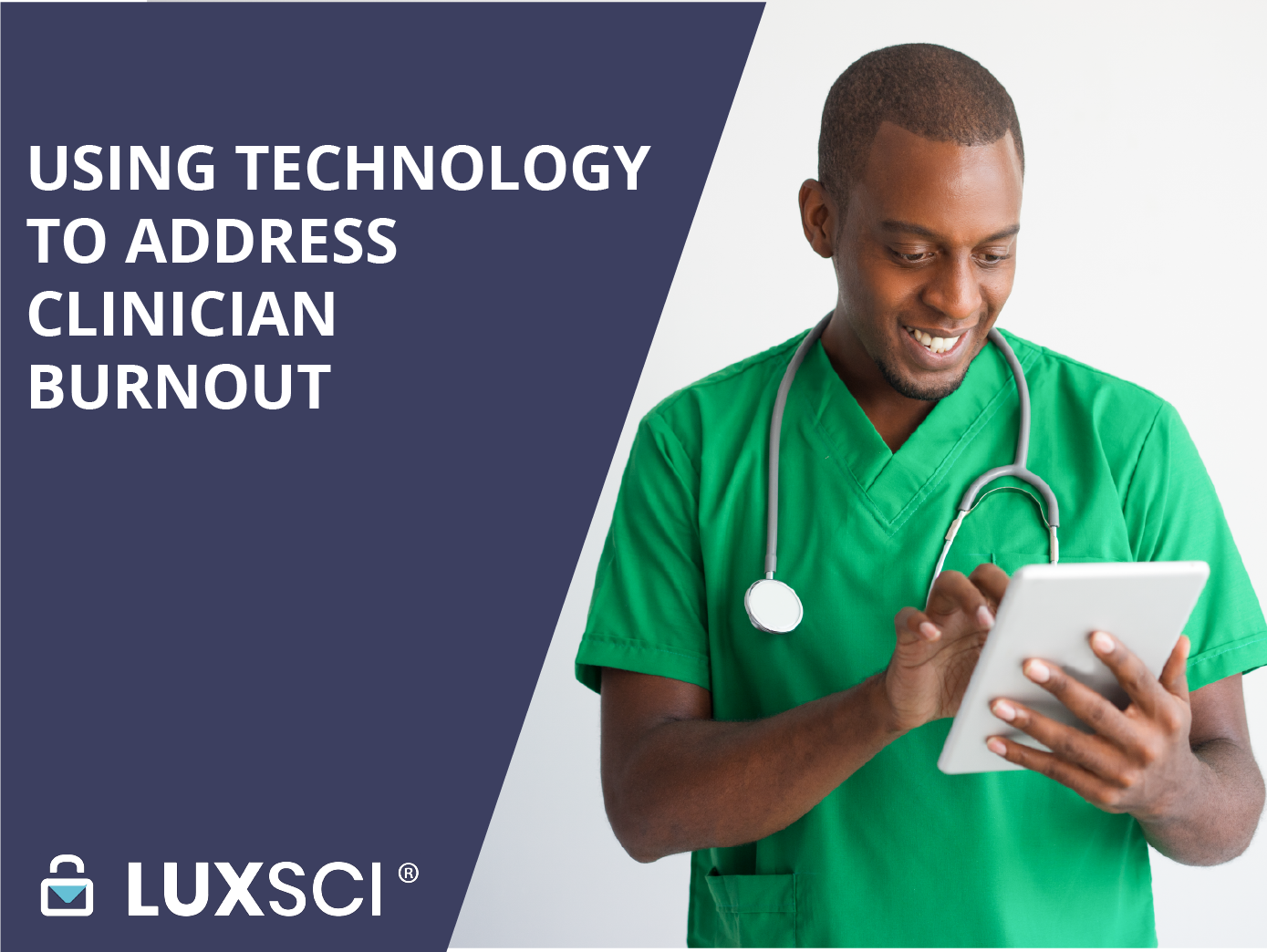Recent survey results from CVS Health indicate that healthcare patients desire a more personalized healthcare experience. Over the last ten years, the online experience has become highly customized. Online vendors have more customer data and use it to extend personalized offers, reminders, and updates. Although people are concerned about online privacy, they are more likely to open and engage with relevant marketing communications.
As the healthcare industry has undergone digital transformation, more data is available in a digital format. But how and when can it be used? This article discusses how to use patient data to personalize healthcare communications without violating HIPAA requirements.

What is Healthcare Personalization?
Personalized health care places individuals at the center of the health care experience. Health care is a complex issue, and one system does not work for everyone. A person’s health status is influenced by many factors, including genetics, age, environment, social determinants, income, and countless others. A health care program that considers as many of these variables as possible can better address patient needs and increase access to care.
Why Personalize Healthcare Communications
Patients understand that their healthcare providers manage a lot of their personal data and want a personalized experience that respects their preferences. As audience segmentation and personalization techniques become more common in other industries like e-commerce and personal care, consumers expect the same experiences from their health care providers.
For example, say you order a jug of laundry detergent on Amazon. They can use common consumer data in combination with your last order date to estimate when you are likely to run out. Then, they can send an email reminder to encourage a reorder before you run out again. In a similar manner, healthcare providers should know when someone’s prescription is running low and could send a notification to let the patient they need to refill and help improve medication adherence.
A recent survey by CVS Health found that 85% of patients find personalized care to be important. In fact, 83% expect their primary care provider to be aware of their family medical history, genetics and inherited lifestyle habits. 71% of consumers said it was very or somewhat important to their health that they have customized alerts and reminders of screenings and checkups. This is even more common among patients under 40. The next generation of healthcare consumers expects their healthcare to fit seamlessly into their normal lives.
Ways to Personalize the Healthcare Experience
There are many ways to personalize the healthcare experience, but they all depend on the available data. An easy way to start is by asking for patient preferences. Some common ways to personalize healthcare communications include collecting information about patient preferences:
- Communication methods: How do they prefer to be contacted? Ask patients their preferred channels- email, texting, phone, and paper notifications are standard options.
- Language proficiency: Is English their first language? If not, send communications in the person’s primary language.
- Patient status: Are they active patients or overdue for regular screenings and appointments?
Looking at these attributes can help craft messages that appeal to patient subgroups.
The next level of personalization uses protected health information (PHI) to deliver extremely customized healthcare communications. The possibilities are truly endless, but here are a few examples to spark some ideas:
- Medical conditions: use information about patient medical conditions to send highly targeted communications about managing or preventing chronic conditions like depression, diabetes, and heart conditions.
- Screening reminders: Remind patients when they are due for mammograms, colonoscopies, or other screenings that are ordered based on age or risk factors.
- Patient retention and re-engagement: Did a patient skip their annual appointment or screening? Make it easy to reschedule by sending periodic reminders.
- Insurance status: send relevant communications based on the patient’s insurance status. For example, letting healthcare marketplace insurance holders know about re-enrollment periods to ensure they don’t drop their coverage.
Personalization provides a customizable healthcare experience for patients that eliminates friction and barriers to care. Using personalization to create educational campaigns can also help improve health outcomes. See How to Use ePHI to Segment and Personalize Email Marketing Campaigns for more information.
HIPAA Considerations in Customizable Healthcare
One reason that healthcare has been slow to adopt personalization techniques is HIPAA. These guidelines protect sensitive medical information and govern how it can be used. To send personalized messages like the examples discussed above, HIPAA guidelines must be followed. Some of the core requirements for sending HIPAA-compliant emails include:
- Encryption
- Access Controls
- Backups and Archival
- Anti-Malware Defenses
- Identity Authorization
- Reporting Mechanisms
- Review Procedures and Policies
Building Patient Trust Through Transparent Personalization
Healthcare organizations implementing personalization strategies face unique challenges in building patient trust while using sensitive medical information for communications. Patients express conflicting desires for personalized experiences alongside concerns about how their health data is being used for outreach purposes. Transparency about data usage helps healthcare providers build trust by explaining exactly what information is used for personalization and how patients can control their communication preferences.
Clear opt-in procedures allow patients to choose the level of personalization they want to receive, from basic appointment reminders to detailed condition-specific education campaigns. Granular preference controls enable patients to select communication topics while declining others, such as accepting medication reminders while opting out of promotional messages about elective procedures. These preference systems need to be easily accessible and regularly updated to reflect changing patient needs and comfort levels.
Patient education about the benefits of personalized healthcare communications helps individuals understand how sharing their information can improve their care experience. Healthcare providers can demonstrate value by showing patients how personalized reminders have improved medication adherence rates or how targeted education has helped similar patients better manage their conditions. This educational approach builds trust while encouraging appropriate data sharing for beneficial personalization.
Privacy dashboards give patients visibility into how their information is being used for communications, including what data points drive message personalization and how often they receive different types of communications. These transparency tools help patients feel more comfortable with personalization while providing healthcare organizations with valuable feedback about patient preferences and concerns.
Behavioral Analytics and Communication Timing
Patient engagement patterns provide valuable insights for optimizing the timing and frequency of personalized healthcare communications. Analytics platforms can identify when individual patients are most likely to open emails, respond to appointment requests, or engage with educational content. These behavioral insights help healthcare organizations deliver messages when patients are most receptive, improving response rates and health outcomes.
Communication cadence optimization prevents message fatigue while ensuring patients receive important health information. Some patients prefer frequent touchpoints with their healthcare providers, while others become overwhelmed by too many messages. Automated systems can adjust communication frequency based on patient engagement levels and preferences, reducing unsubscribe rates while maintaining effective health communication.
Seasonal and lifecycle-based personalization recognizes that patient communication needs change based on life events, health status changes, and time of year. New patients may need more frequent educational communications during their first months with a provider, while established patients might prefer less frequent but more targeted messages. Pregnancy, chronic disease diagnosis, or aging can trigger different communication strategies that better serve patient needs during specific life phases.
Predictive modeling helps healthcare organizations anticipate patient communication needs before they arise, such as identifying patients who are likely to miss appointments or forget medication refills. These predictive capabilities enable proactive outreach that prevents health issues rather than simply reacting to problems after they occur.
Regulatory Compliance in Personalized Healthcare Messaging
Marketing authorization requirements under HIPAA create specific obligations for healthcare organizations that want to use PHI for personalized communications. Patients have the right to opt out of marketing communications while still receiving treatment-related messages, requiring healthcare organizations to carefully categorize their communications and maintain separate authorization tracking for different message types.
Minimum necessary standards apply to personalized healthcare communications, requiring organizations to limit the amount of PHI used in messages to what is needed for the specific communication purpose. Personalization algorithms should be designed to achieve their objectives while minimizing PHI exposure, both in message content and in the data processing required to generate personalized communications.
Documentation requirements for personalized healthcare communications include maintaining records of patient authorization, message content, and personalization criteria used for different communication campaigns. These records support compliance audits and help healthcare organizations demonstrate that their personalization practices align with HIPAA requirements and organizational policies.
Business associate agreements with email marketing platforms need specific language covering how PHI can be used for personalization purposes, including data processing limitations, security requirements, and restrictions on data retention or secondary use. Healthcare organizations cannot assume that standard marketing platform contracts provide adequate protection for healthcare personalization activities.
Technology Infrastructure for Healthcare Communication Personalization
Data integration platforms enable healthcare organizations to combine information from electronic health records, practice management systems, and patient engagement platforms to create comprehensive profiles for personalization. These integration efforts require careful attention to data security and access controls to ensure that personalization systems don’t create new vulnerabilities or inappropriate access to patient information.
Real-time data synchronization ensures that personalized communications reflect current patient information, including recent appointments, test results, or treatment changes. Delayed data updates can result in inappropriate or confusing messages that undermine patient trust and care coordination. Healthcare organizations need to balance the frequency of data updates with system performance and security considerations.
Machine learning algorithms can identify personalization opportunities that human staff might miss, such as patients who would benefit from specific educational content based on their medical history and engagement patterns. These automated personalization capabilities need human oversight to ensure that algorithmic decisions align with clinical best practices and patient preferences.
API security for personalization platforms requires special attention because these systems often need access to multiple healthcare data sources to create personalized communications. Strong authentication, encryption, and access logging help ensure that personalization platforms can access necessary data while maintaining security controls over PHI usage and transmission.
Measuring Personalization Effectiveness and Patient Outcomes
Engagement metrics help healthcare organizations evaluate whether personalized communications improve patient response rates compared to generic messaging approaches. These metrics include email open rates, click-through rates, appointment scheduling rates, and medication adherence improvements that can be attributed to personalized communication strategies.
Patient satisfaction surveys can measure whether personalized communications improve the overall healthcare experience and identify areas where personalization efforts might be missing the mark. These surveys help healthcare organizations understand patient preferences for communication content, frequency, and delivery methods while gathering feedback about privacy concerns or personalization preferences.
Health outcome tracking connects personalized communication efforts to measurable improvements in patient health metrics, such as better medication adherence, increased screening participation, or improved management of chronic conditions. These outcome measurements help justify the investment in personalization technology while identifying the most effective personalization strategies for different patient populations.
Cost-benefit analysis of personalization efforts includes both direct costs like technology platforms and staff time alongside benefits like reduced no-show rates, improved patient retention, and better health outcomes. Healthcare organizations can use this analysis to optimize their personalization strategies and demonstrate return on investment for communication technology investments.
See our HIPAA-Compliant Email Checklist for more information about the requirements.
LuxSci offers several solutions for sending HIPAA-compliant personalized messages. Contact us today to learn more about our Secure High Volume Email and Secure Marketing tools.










